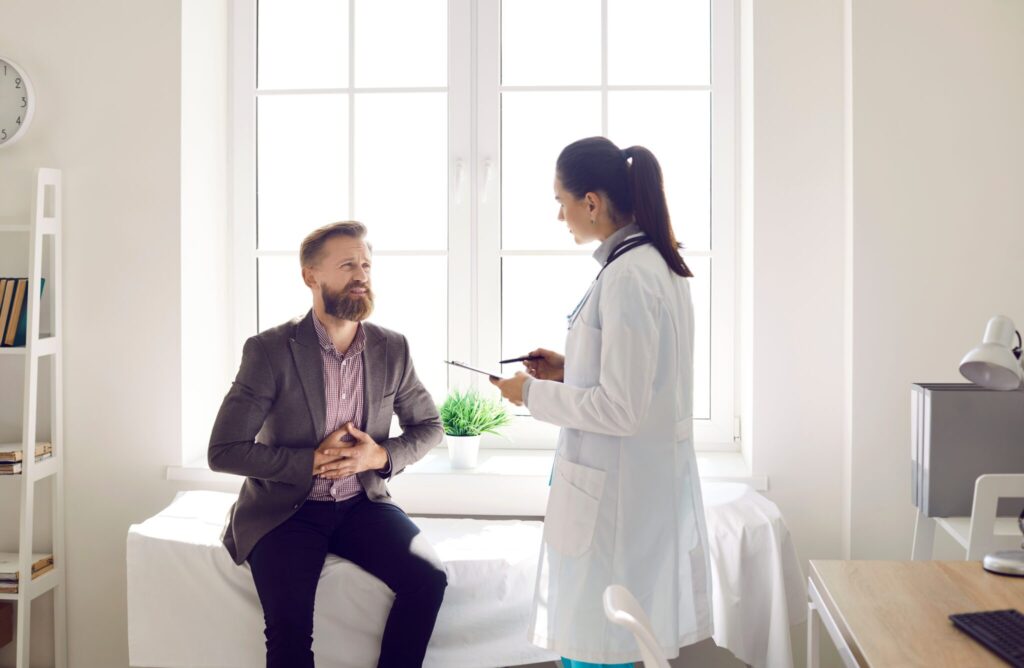Understanding EGD/Upper Endoscopy: A Comprehensive Guide for Conyers, GA Residents

- colondigestive
- April 29, 2024
- 4:27 am
- No Comments
Introduction: The Significance of EGD in Modern Gastroenterology
In the intricate landscape of gastroenterology, especially within the Conyers, Georgia community, the advent of Esophagogastroduodenoscopy (EGD), universally known as Upper Endoscopy, has marked a pivotal advancement in diagnosing and managing upper gastrointestinal ailments. This minimally invasive procedure transcends traditional diagnostic methods, offering a direct visualization of the esophagus, stomach, and duodenum. It serves as a cornerstone in the assessment and treatment of various conditions, making it a crucial tool for gastroenterologists in Conyers and beyond. An EGD enables the identification and management of symptoms such as abdominal pain, nausea, and unexplained weight loss, offering hope and solutions to those suffering from gastrointestinal disorders.
The Procedure Explained: A Journey Through the Upper GI Tract
The EGD procedure is a remarkable journey through the upper gastrointestinal (GI) tract, offering a close-up view of the esophagus, stomach, and duodenum. This minimally invasive diagnostic tool is pivotal for gastroenterologists in Conyers, GA, and beyond, as it bridges the gap between symptom presentation and accurate diagnosis. The process begins with the careful introduction of an endoscope, a flexible tube fitted with a camera and light, through the mouth and into the upper digestive system. As the endoscope winds its way through the GI tract, it transmits high-resolution images back to a monitor, allowing the physician to examine the mucosal lining in real time.
This procedure is not just about observation; it’s a conduit for action. Equipped with tools for biopsy, the endoscope can collect tissue samples from the lining of the GI tract for further analysis, a crucial step for diagnosing conditions ranging from celiac disease to cancer. Moreover, the EGD can also play a therapeutic role, such as removing polyps or treating bleeding lesions, showcasing its versatility beyond mere diagnosis.
The significance of an EGD in gastroenterology cannot be overstated. It allows for the direct visualization of the upper GI tract that may not be apparent through other diagnostic methods, providing clear evidence of inflammation, ulcers, tumors, or other abnormalities. This direct approach ensures a more accurate diagnosis, guiding the next steps in treatment with precision. For residents of Conyers, GA, and the surrounding areas, the availability of this procedure represents access to advanced gastroenterological care, ensuring that conditions can be diagnosed and treated with the highest level of expertise.
The procedure typically lasts between 15 to 30 minutes, during which patients are under sedation to ensure comfort and minimize anxiety. The use of sedation is a testament to the patient-centered approach adopted by gastroenterologists, emphasizing the importance of a pain-free and stress-free experience. Once the procedure is complete, the endoscope is carefully withdrawn, marking the end of the journey through the upper GI tract. The insights gained from this exploration are invaluable, laying the groundwork for a targeted treatment plan tailored to the patient’s specific condition.
Preparing for Your EGD: Key Steps for a Smooth Procedure
Preparing effectively for an EGD is crucial for the success of the procedure and your comfort. Here are essential steps to ensure a smooth experience:
Fasting
A clear view of the upper GI tract is essential, so you’ll need to fast for 8-12 hours before the procedure. This means no food or drink to ensure the stomach and duodenum are empty for optimal examination.
Medication Adjustment
Review your medications with your doctor, especially those affecting blood clotting or blood sugar levels. Some medications may need to be paused or adjusted to minimize risks during the EGD.
Arrange Transportation
Due to the sedative used, you won’t be able to drive post-procedure. Arrange for someone to take you home, ensuring you can safely return without driving yourself.
Understand Sedation
Knowing what to expect from the sedation can ease anxiety. You’ll be sedated but awake, likely with little memory of the procedure afterwards. Discuss any concerns with your doctor beforehand.
Mental Preparation
Finally, mentally preparing for the procedure can help alleviate stress. Remember, an EGD is a common, generally safe procedure that provides valuable insights into your gastrointestinal health.
By following these steps, you can approach your EGD with confidence, knowing you’re prepared for a successful and informative examination.
What to Expect During the Procedure
When undergoing an EGD, knowing what to expect can help ease any apprehensions. Here’s a brief overview of the procedure to help you prepare:
Arrival and Preparation
Upon arrival at the facility, you’ll be checked in and taken to a pre-procedure area where your vital signs will be monitored. You’ll be asked to remove any dentures or oral appliances. This is also when you’ll discuss the sedation process with the anesthetist who will explain how it will help keep you comfortable throughout the procedure.
Sedation
Before the EGD begins, you’ll receive sedation through an IV to help you relax. While sedated, you’ll remain awake but in a state of reduced awareness, ensuring you feel no discomfort. The level of sedation varies from light to deep, depending on individual factors and doctor’s discretion.
The EGD Procedure
During the EGD, you’ll lie on your side on the examination table. A mouth guard may be placed to protect your teeth and the endoscope. The gastroenterologist will then gently insert the endoscope through your mouth and into the esophagus, stomach, and duodenum. As the endoscope moves, it transmits video images to a monitor, allowing the doctor to examine the lining of your upper GI tract closely.
You may feel mild discomfort, such as pressure or bloating, as air is used to inflate the stomach to provide a better view of the GI lining. If necessary, the doctor can use tiny instruments through the endoscope to perform biopsies or treat certain conditions detected during the examination.
Monitoring Throughout the Procedure
Your healthcare team will closely monitor your vital signs and comfort level throughout the procedure to ensure your safety. Adjustments to the level of sedation can be made as needed.
Duration
The entire EGD procedure typically lasts between 15 to 30 minutes, depending on what is found and whether any additional procedures, like biopsies, are performed.
Understanding these key aspects of the EGD procedure can help you feel more prepared and less anxious about the experience. Remember, the goal of the EGD is to provide valuable insights into your health, guiding effective treatment if necessary.
After the Procedure: Recovery and Results
After an EGD is completed, the recovery phase begins, which is crucial for ensuring your well-being and understanding the findings of the procedure. Here’s what you can expect during this period:
Immediate Post-Procedure Recovery
Once the EGD is finished, you will be moved to a recovery area where your vital signs will continue to be monitored as the sedation wears off. The effects of sedation can vary, but most patients start to feel more alert within a few minutes to an hour after the procedure. It’s normal to feel a bit groggy or drowsy during this time, so rest and relaxation are important.
Managing Discomfort
You might experience mild throat soreness or discomfort, and possibly bloating or gas due to the air introduced into your stomach during the procedure. These symptoms are typically short-lived and should resolve on their own within a few hours. Sucking on throat lozenges or drinking warm teas can help alleviate throat discomfort.
Discharge and Transportation
Due to the sedative used during the procedure, you’ll need someone to drive you home, as it’s unsafe to drive or operate heavy machinery for the remainder of the day. Before discharge, your healthcare provider will give you specific post-procedure instructions, including when to resume eating and drinking, medication adjustments, and any activity restrictions.
Understanding Your Results
Immediately after the EGD, your gastroenterologist may provide a preliminary overview of the findings. However, if biopsies were taken or if further analysis is required, it may take several days to receive these results. A follow-up appointment is usually scheduled to discuss the outcomes in detail, including any necessary next steps such as additional tests, treatments, or lifestyle changes.
Follow-Up Care
Adhering to your doctor’s post-procedure instructions is crucial for a smooth recovery. This includes following dietary recommendations, taking prescribed medications, and monitoring for any signs of complications, although these are rare. Symptoms such as severe abdominal pain, fever, or significant throat pain should be reported to your healthcare provider immediately.
The recovery phase after an EGD is generally straightforward, with most patients resuming normal activities by the next day. The results from the procedure can provide valuable insights into your gastrointestinal health, guiding your care team in developing an effective treatment plan tailored to your needs. Remember, the goal of the EGD is to ensure your digestive health is managed with the highest care, and your active participation in the recovery process plays a key role in achieving this outcome.
Conclusion: EGD as a Pillar of Gastrointestinal Health in Conyers, GA
EGD/Upper Endoscopy is a testament to the advancements in gastroenterology, offering invaluable insights into the upper digestive tract crucial for diagnosing and treating gastrointestinal diseases. As this technology continues to evolve, it remains a key component of patient-centric care, particularly in the Conyers, GA area. At Colon & Digestive Health Specialists, located at 1805 Honey Creek Commons, Ste B, Conyers, GA 30013, our team is committed to utilizing this diagnostic tool to its fullest potential. With a focus on providing the highest standard of care, we ensure that each patient receives personalized attention and tailored treatment plans. For more information or to schedule an appointment, please contact us at (770) 922-7000 or visit our website at www.colondigestive.com. Our dedication to improving digestive health in Conyers and the surrounding communities remains unwavering, as we continue to offer advanced care options and support to our patients every step of the way.
© 2024 All Rights reserved © 2024 by Colon & Digestive Health Specialists

